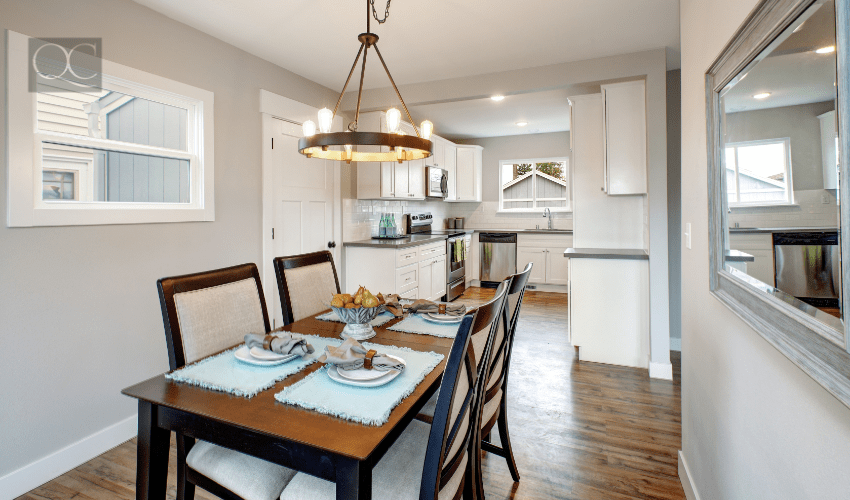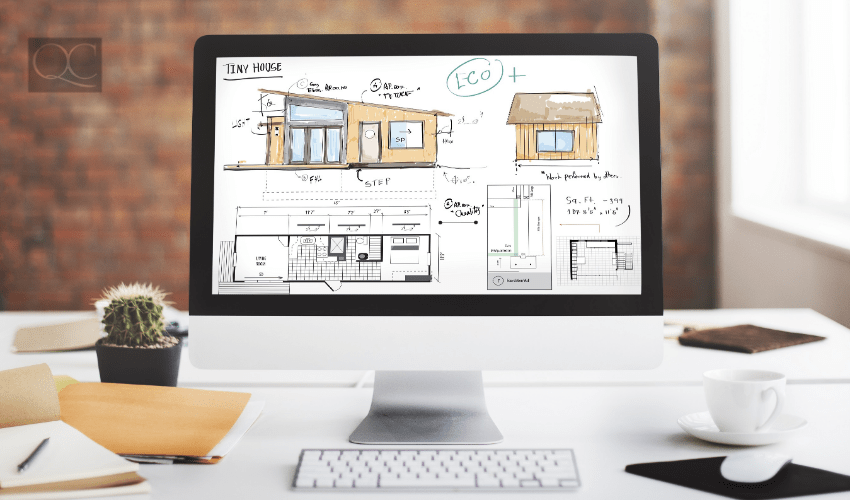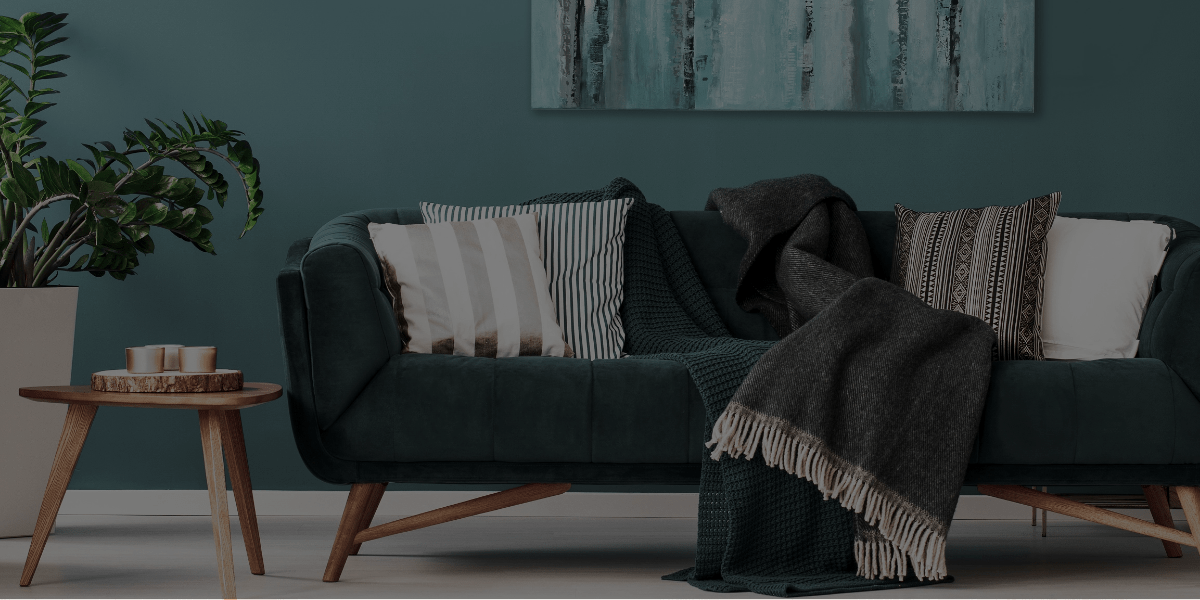As a professional designer, many of the clients you work with won’t know what their preferred design style is. Not sure how to help them decide? QC Student Ambassador, Alexa Jorgenson, is here to help! Learn more about Alexa by reading her Ambassador Feature here. You can also connect with her directly in QC’s Virtual Classroom on Facebook!

”If you love something, it will work. That’s the only real rule.
Bunny Williams
Common Design Styles You NEED to Know!
Helping clients identify their preferred design style is a way of helping them make their vision come to life. Some clients know exactly what they want, whereas others may think they know what they want. In some cases, your client won’t have any idea at all! As the subject-matter expert, it’ll be up to you to help clients determine their style. This way, you can begin guiding them in the right direction.
This article will help designers and aspiring designers alike navigate the style identification process that comes with each client. Like world-renowned interior designer, Bunny Williams, indicates: the only real rule in design is to make sure your clients LOVE the design itself!
So, how can you assist them with this? Where should you start? In my opinion, the jumping-off point should be acquiring the ability to identify common design styles in the first place.
As a design associate, I have learned that there are approximately six common design styles:
- Modern;
- Contemporary;
- Traditional;
- Transitional;
- Casual;
- And Formal.
These styles can be mixed or used on their own. Furthermore, they can also include various themes, depending on what the client wants.

Breaking Down The 6 Most Common Design Styles
Modern
A modern design style – a.k.a. Mid-Century Modern – is a defined style that consists of clean, simple, and natural furniture pieces. White walls are common, as are furniture pieces made of wood, leather, linen, and polished metal that are raised off the ground. Bare floors also give this design style an airy, open feel.
Contemporary
A contemporary design style is different from modern. This is because contemporary refers to the current time, which changes fluidly. This particular style typically uses clean lines as well – but it also uses colorful or oversized art pieces, too.
Traditional
The traditional design style stems from Europe during the 18th and 19th centuries. We can identify this style by its use of heavy furniture pieces. Dark woods, claw-foot and tufted chairs, high-end fabrics, columns, and symmetry are also common.

Transitional
The transitional design style is a mix of contemporary and traditional. Similar to contemporary, a transitional style typically uses neutral colors. But like with the traditional style, transitional design generally uses furniture pieces of classic shapes.
Casual
The transitional design style is a mix of contemporary and traditional. Similar to contemporary, a transitional style typically uses neutral colors. But like with the traditional style, transitional design generally uses furniture pieces of classic shapes.
Formal
Lastly, the formal design style consists of furniture pieces that are elegant, regal, ornamental, tall, and grandesque. Carved details and symmetry are keys to identifying this particular style.

Signs That Your Client Hasn’t Identified Their Preferred Style
A home design professional notices when a client has yet to identify their preferred style. Clear giveaways that a client does not yet know their design style include (but are not limited to):
- They outright tell you that they don’t know what they want.
- The client can’t seem to properly vocalize what it is they want.
- They are having trouble making a final decision.
- They’re not LOVING anything they’ve tried thus far.
- They seem to want to give up altogether on redesigning their space.
It’s common for problems like these arise. Just know that the appointment is NOT over yet! Lucky for us, there are many ways a professional designer can turn the appointment around and into a success. With your help, the client can properly determine the right design plan and will be ecstatic to see it come to life!
How to Help
In this case, technology can be our best friend! You could start by showing your client some 3D room plans from other projects you’ve completed. This can help you to gauge their preferred design style. Ask clients to point out which aspects of the 3D rooms they like most, as well as the parts they don’t like.
Another way to identify your clients’ ideal design style is to bring various upholstery and rug samples to the appointment. Showing clients design ideas both virtually and in-person (with real materials) will help narrow things down. Once you’re able to help them decide which direction they want to go in, you can then create a mood board to bring the overall vision together. This board can be virtual or physical, depending on your clients’ preferences.
The key with the mood board is to help your client better understand what type of design style they prefer. After all, talking about different design styles and/or showing them small samples might not be enough. They could still lack the proper understanding and be left unsure. As design professionals, we need to not only tell – but show.

Showing Different Styles to Your Design Clients
So, to quickly sum up what we’ve discussed so far: first, know how to distinguish between different design styles. Secondly, be able to show clients these styles through sample 3D room plans and mood boards.
It’s also important to note that it’s totally okay to mix design styles! Many clients will like a combination of multiple designs. Therefore, you should always ensure to show unsure clients multiple different styles. This way, they’ll be better able to identify which aspects they like from each one.
Once again, this is why it’s critical to always tell AND show!
There are tons of online resources that you can use to your advantage, such as DesignFiles and Pinterest. On these platforms, you’ll be able to research a multitude of various design visions. Furthermore, tablets can also be quite useful. Plenty of home designers like to store their virtual projects on tablets because it’s easy to transport and provides a convenient way to show past work to clients.
Did You Know?: Until April 5th, enroll in ANY QC Design School Course and get a FREE 4-month subscription to DesignFiles! We’ll also throw in 2 additional courses at NO extra cost! Learn more about this limited-time promotion here.
3 Common Mistakes to Avoid
Technically, there are no rules when it comes to design. At the end of the day, it’s all about your client, their preferences, and their vision. That being said, there are 3 mistakes that designers commonly make make which are easily avoidable…

Mistake #1: Only creating your preferred design style.
Simply put: don’t be this type of designer! As a design associate, I have learned to look at every upholstery sample as one that is beautiful. For example, I work with over 900 fabrics. Each one serves a unique purpose in every client’s personal, beautiful vision.
If you know that you have a tendency of sticking to your own preferred styles, then now’s the time to broaden your horizons. After all, you’ll need to be able to work with ANY style at the drop of a hat. One way that I learned to see the beauty in each fabric sample was to work on practice projects. These projects allowed me to discover how to work with each style in various different situations.
Mistake #2: Overwhelming clients.
Too many design terms or broad questions can quickly overwhelm and/or confuse a client – especially one with little to no industry knowledge. For instance, my store is familiar to me, but it’s foreign to customers. All of the furniture and various designs surrounding them can quickly become a bit much.
Now imagine if, on top of that, I started throwing design terms at them or asking all sorts of open-ended questions right away. They’ll want to turn around and walk right out the door!
Instead, break down the process. Let them know you are there to help them. Everything you explain after that needs to be thought-out and easy to understand. A client with no prior design experience should still be able to get what you’re telling them.

Mistake #3: Not getting professional certification training.
How can you be a true industry expert if you haven’t gotten professionally trained? Not having reputable training probably means that you don’t thoroughly understand the many different design styles that’re out there. At least, not with the level of expertise that your customers and clients are expecting from you.
This is a huge mistake – and one that will negatively impact your career and its success. To avoid this, QC Design School offers aspiring and experienced design professionals alike the tools and proper education needed to become certified, confident professionals in the industry.
The Most Important Part: Listening!
A takeaway from this article is that the most important part of being a good designer is listening. When interacting with a client, make eye contact, nod, and repeat back what they say to you. All of this will show them that you’re genuinely hearing them and their requests.
Moreover, listening to what clients don’t say is also important, too!

Did you enjoy reading this article? Are there any other tips you have for helping clients identify their preferred design style? If so, then please leave a comment below and share your thoughts.
Thanks so much for reading! 🙂



Great information! Working with clients can sometimes be challenging and knowing these styles and tips will always help 🙂
You did a really great job on this article!!
Thanks so much for reading and for leaving such a kind comment, Melissa. We’re sure Alexa will really appreciate it! <3
All the best,
The QC Team
This is so helpful! I find there are also clients who want the same style throughout their whole house but then the other type of client who wants to try different styles in different rooms – which I personally love doing myself!!